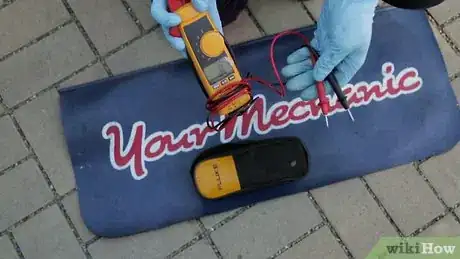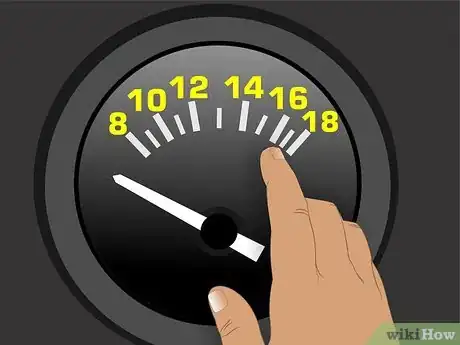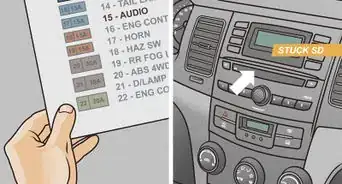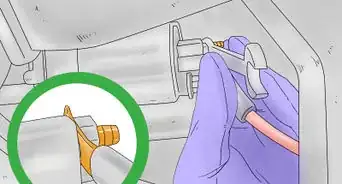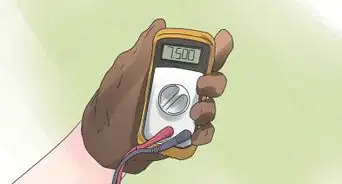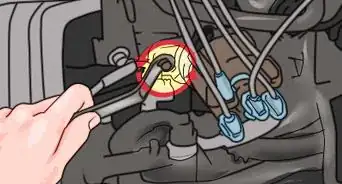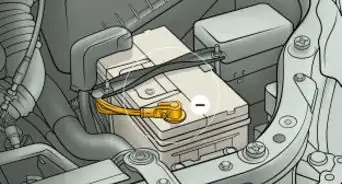This article was co-authored by Jay Safford. Jay Safford is an Automotive Consultant and Project Manager. He is Automotive Service Excellence (ASE), NAFA Fleet Management Association, Ford, and L1 Certified. He has over 15 years of automotive repair experience and has served as an Automotive Instructor at the Lincoln Technical Institute in West Palm Beach, Florida.
There are 7 references cited in this article, which can be found at the bottom of the page.
wikiHow marks an article as reader-approved once it receives enough positive feedback. In this case, 91% of readers who voted found the article helpful, earning it our reader-approved status.
This article has been viewed 248,668 times.
Not sure if your alternator is in tip top shape? It’s hard to tell whether or not an alternator works if you don’t know what to look for. The easiest way to test it is by using a voltmeter. If you're well in tune with your car, there are a few other methods you may try as well. This test is to give a general health of your alternator and battery. Some newer vehicles may have computer controlled charging systems and would require additional testing.
Things You Should Know
- Use a voltmeter to check your alternator; rev your engine to 2000 RPM, keep the engine running, and test the battery with the voltmeter.
- If your voltage goes from ~12.2 V to ~13-14.5 V, your alternator is doing well. If your V stays the same or decreases, that's a bad sign.
- Alternatively, take your car into an autobody shop that's willing to test your alternator for you, free of charge.
Steps
Using a Voltmeter
-
1Buy a voltmeter. You can find one at any auto parts store for less than $20.[1] Don't worry about getting an expensive one; a cheap voltmeter will do for this purpose.
- If you have a multimeter, you can use that instead. A multimeter measures voltage as well as other electrical properties such as current and resistance. You want to measure voltage when you're checking your alternator.[2]
-
2Check the battery first. The battery is needed to start the vehicle, which, in turn spins the alternator at sufficient speed to keep the battery charged. This means that if your battery is too low, you will be unable to start the vehicle and thus you will also be unable to test the alternator, rendering any additional voltmeter-testing totally useless. If the weather is cold or your battery is old, your battery could be the issue and your alternator might be just fine. That's why you need to check the battery before checking the alternator.[3] Here's how to do it:
- Turn off the car. You'll want to make sure your engine is off before attaching the voltmeter.[4]
- Open the hood.
- Connect the voltmeter to the battery. Place the red lead of the voltmeter to the positive battery terminal and the black lead to the negative terminal. Avoid touching your skin to the battery.
- Read the voltmeter. If the battery reads above 12.2 volts, it has enough juice to start the alternator, which can then be tested with the voltmeter.
- If the battery doesn't have enough voltage, either get the battery charged and re-test or try a different method for checking the alternator.
Advertisement -
3Start the vehicle and rev the engine to 2,000 RPM. This will draw power on your battery, which should cause your voltage regulator to kick the alternator into high gear.
-
4Keep the engine running and retest the battery with the voltmeter. When you read the voltmeter this time, the voltage should go up to at least 13. If varying the RPMs causes the voltage to fluctuate between 13 and 14.5 volts, your alternator is in good shape; if, on the other hand, the voltage remains the same or decreases, your alternator isn’t working properly.[5] [6]
- Repeat the process with the lights, radio, and AC on. The alternator is charging if the battery voltage stays above 13 volts with the engine at 2,000 rpm and all accessories on.
Monitoring Your Alternator
-
1Check the alternator gauge. If you have a volt/amp gauge, it will read the alternator output for you. Run engine at 2,000 rpms for tests and turn on the blower fan for the AC or Heater, the headlamps, and any other accessories that put a strain on the alternator, and watch the gauge to see if it decreases voltage or amperage. As a rule, if the voltmeter is higher when the engine is running than when the engine is not, you can confidently assume that the alternator is charging.
-
2Listen to the alternator while the engine is running. If there is a problem with the bearings you may hear a squealing sound coming from the front of the car, which becomes louder with more electrical accessories using power at the same time.[7]
-
3Turn the radio on and rev the engine. Tune your radio to a low number on the AM band with no music. If the radio whines or goes fuzzy whenever you hit the gas, the alternator is quite likely the culprit.[8]
-
4Find an auto-parts store that tests alternators for free. Since every store would love for you to buy your new alternator from them, many will try to get the edge-up on their competitors by offering free testing. Dismount your alternator and bring it in to be sure.[9]
Warnings
- Some people recommend testing the alternator by starting the car, loosening the negative battery cable, and waiting to see whether or not the engine dies. Do not attempt this method; it can fry the voltage regulator, the alternator, and/or the electrical components.⧼thumbs_response⧽
- Keep hands, loose clothing, long hair and jewelry away from moving parts when checking under the hood of the car with the engine running.⧼thumbs_response⧽
References
- ↑ http://www.familyhandyman.com/automotive/how-to-test-an-alternator/view-all#step1
- ↑ https://differencecamp.com/voltmeter-vs-multimeter-differences/
- ↑ https://www.carsdirect.com/car-maintenance/car-battery-or-alternator-how-to-tell-where-the-problem-lies
- ↑ https://haynes.com/en-us/tips-tutorials/how-test-car-battery-multimeter
- ↑ http://www.familyhandyman.com/automotive/how-to-test-an-alternator/view-all#step1
- ↑ http://www.todayifoundout.com/index.php/2010/01/how-to-test-a-car-alternator/
- ↑ https://www.yourmechanic.com/article/how-to-test-your-alternator_2
- ↑ https://www.yourmechanic.com/article/how-to-test-your-alternator_2
- ↑ https://www.autozone.com/landing/page.jsp?name=in-our-stores
About This Article
The alternator in your car is responsible for recharging your car’s battery and powering the electrical system. If your headlights aren’t as bright as they usually are, your car’s electrical system isn’t working properly, or you’re having trouble starting your car, those could all be signs that your alternator isn’t working properly. Fortunately, you can easily test your car’s alternator to see if it's working using a voltmeter, which is an instrument that measures voltage. Before you test the alternator, you’ll need to make sure your car’s battery is fully charged. Turn your car off, pop the hood, and connect the voltmeter’s positive probe to the positive terminal on the battery and the negative probe to the negative terminal on the battery. Then, check the reading on the voltmeter. If it’s less than 12.2, you’ll need to charge your battery before you can test the alternator. Otherwise, have a helper start your car and rev the engine to 1500 RPM. Check the reading on the voltmeter again. The voltage should increase by between 0.5 and 2 volts to around 13.6 to 15.8. If the reading stays the same or drops, that means the alternator isn’t charging and you may need a new one. If the reading is more than 2 volts higher, that could mean that your alternator is overcharging. Either way, take your car to an auto repair shop to find out what’s wrong. To learn how to diagnose an alternator problem by checking the gauge or by sound, keep reading!
